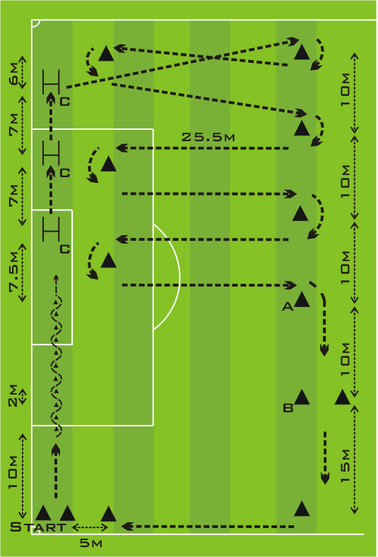Football specific endurance test
To our knowledge there are two field test that can be used to measure players aerobic endurance. Commonly there are called football-specific tests as they are thought to replicate football specific actions (such as movement with the ball and different activities, e.g. running forward, backwards, rest) and therefore measurements are taken in a football-specific content. The two tests are named after their inventor Hoff (7) and Bangsbo (1) - see references below.
The Hoff-test
Originally, the Hoff-test was used as a training tool and not necessarily for testing purposes (7).
The goal in this test is to cover as much distance as possible - if the distance is the desired final measure.
If a portable metabolic system is used, then the intensity should is gradually increased with the purpose that the players reach their VO2max
within 6 minutes (2).
Unfortunately, there seems to be no information about the reliability of the test, however, the test seems to be have a good validity (5, 8).
From a practical point of view, a specific duration (i.e. 10 minutes) is used for players performing the test. The final performance measure is the distance covered during the 10 meters (5).
Other scientific investigations in football used the Hoff-test to measure training effects after 8 weeks of training (5) and showed significant correlation (r = 0.70) between the test and
sprinting distance in match performance (3).

Generally, the 290 m test is performed in a forward dribbling motion.
However, at points C players pass the ball under a 30-centimerter height hurdle and jump over the hurdle. From point A to point B players need to dribble backwards.
The Bangsbo-test
The Bangbso test alternates between high- and low-intensity exercise for 15 and 10 seconds, respectively with a total duration of 16.5 minutes. During the high-intensity periods the player performs different locomotion pattern, while the 10-seconds active recovery was spend in jogging (1). The test was shown valid in male professional soccer players (1), however, test performance was not significant correlated with VO2max in youth soccer players (4).
The test performance is the distance covered during the 40 periods of high intensity running.

References
1. Bangsbo, J. and Lindquist, F. Comparison of various exercise tests with endurance performance during
soccer in professional players. Int. J. Sports. Med. 13: 125-132, 1992.
2. Carminatti, L.J., Possamai, C.A., de Moraes, M., da Silva, J.F., de Lucas, R.D., Dittrich, N., and
Guglielmo, L.G. Intermittent versus Continuous Incremental Field Tests: Are Maximal Variables Interchangeable? J. Sci. Med. Sport. 12: 165-170, 2013.
3. Castagna, C., Manzi, V., Impellizzeri, F., Weston, M., and Barbero Alvarez, J.C. Relationship between
endurance field tests and match performance in young soccer players. J. Strength. Cond. Res. 24: 3227-3333, 2010.
4. Chamari, K., Hachana, Y., Ahmed, Y.B., Galy, O., Sghaier, F., Chatard, J.C., Hue, O., and Wisloff, U.
Field and laboratory testing in young elite soccer players. Br. J. Sports. Med. 38: 191-196, 2004.
5. Chamari, K., Hachana, Y., Kaouech, F., Jeddi, R., Moussa-Chamari, I., and Wisloff, U. Endurance
training and testing with the ball in young elite soccer players. Br. J. Sports. Med. 39: 24-28, 2005.
6. Hill-Haas, S.V., Coutts, A.J., Rowsell, G.J., and Dawson, B.T. Generic versus small-sided game training
in soccer. Int. J. Sports. Med. 30: 636-642, 2009.
7. Hoff, J., Wisloff, U., Engen, L.C., Kemi, O.J., and Helgerud, J. Soccer specific aerobic endurance
training. Br. J. Sports. Med. 36: 218-221, 2002.
8. Kemi, O.J., Hoff, J., Engen, L.C., Helgerud, J., and Wisloff, U. Soccer specific testing of maximal oxygen
uptake. J. Sports. Med. Phys. Fitness. 43: 139-144, 2003.
 Footballscience.net
Footballscience.net
